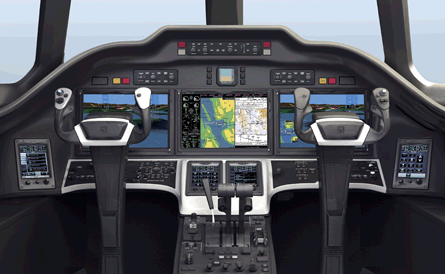Cessna has initiated an extreme makeover of its largest and fastest jet, the $22 million Citation X. Along with upgraded Rolls-Royce AE3007C2 turbofan engines with new fans, the twinjet will host two newcomers to the Part 25 aircraft market - Garmin for the integrated avionics suite and Heads Up Technologies for the cabin management system.
In total, the new Citation Ten (the number will now be spelled out) will boost performance while offering passengers a more modern and comfortable cabin. First flight is expected in December 2011, followed by certification in second quarter of 2013 and service entry in the third quarter of 2013. Cessna has not yet revealed the price.
 |
|---|
© Cessna |
Externally, the Ten features almost the same planform as the "old" version of the jet, the difference being standard equipped elliptical winglets (offered today as an aftermarket add-on at service centres) and a 38cm (15in) fuselage extension just aft of the cabin door.
In part due to a 1.4% improvement in thrust-specific fuel consumption and a 4%, 9% and 7% increase in engine thrust at take-off, climb and cruise, respectively, Cessna is marketing an increase in maximum payload of 97kg (214lb) to 1,140kg, a boost in maximum cruise speed at flight level FL490 to 479kt (886km/h) from 460kt, and a 190nm (352km) increase in range at M0.82 to 3,242nm.
Most of the hubbub on the new design is happening on the inside. The cockpit will feature a G5000 integrated avionics suite built by Garmin, the company's first entry into the transport category (Part 25) realm.
The current Citation X features Honeywell Primus 2000 avionics. From 2011-13 it will be equipped with the Honeywell Primus Elite suite. The Garmin cockpit will feature three 14in (36cm) diagonal WXGA displays, a split-screen multifunction display and four smaller touchscreen control panels for configuring the G5000 flight displays, tuning radios, entering and modifying flightplans, managing aircraft systems and viewing checklists. Garmin also has some traditional controls - dual-concentric knobs, for tuning radios by hand, for example.
Advanced situational awareness and navigation features, including synthetic vision, terrain awareness and traffic on the primary flight display and WAAS LPV and RNP 0.3 navigation capabilities are standard, as are dual flight management and inertial navigation systems.
The three-axis automatic flight control system provides yaw damping and mach trim and couples to the new autothrottle system for an emergency descent mode that provides automatic descent to 15,000ft (4,575m) for cabin pressurisation emergencies at altitude. Another new Garmin product on board will be the GWX 70 weather radar with 30cm antenna and 50W transmitter power, now in development. According to Cessna, the solid-state radar will include automatic range limiting, vertical scan capability and Doppler turbulence detection along with weather target alerting.
 |
|---|
© CessnaThe Cessna Citation Ten features an all new Garmin 5000 Flight deck |
In the cabin, Cessna has selected Heads Up Display Technologies, previously a component provider for in-flight entertainment systems, as the primary provider of the Citation Ten exclusive cabin management system in co-operation with Cessna's in-house design group.
Working through a fibre optic backbone connected to the Garmin G5000, the touchscreens and video display panels hard-mounted into the sidewalls at the eight leather passenger seats in dual club configuration will control entertainment and moving map displays, lighting, window shades and temperature, as well as provide seat-to-seat text messaging.
With the extended cabin and seats turned slightly inboard, Cessna has also increased the roominess and pitch of the seats, which also now have fully stowable arm rests. A new RGB colour-adjustable accent lighting system will wash the side ledges, aisle and cabinetry in a user-selected array of colours.
GARMIN PUTS BEAD ON BIG TIME MARKET
Industry observers knew it was only a matter of time before Garmin reached upward from the Part 23 general aviation market with its pilot-friendly G1000 integrated avionics system, now flying on 7,500 aircraft.
"When we enter a market, we look to span our technology across that market," says product manager Bill Stone. "We couldn't say you'd find us in a Boeing product tomorrow, but the certification standards for Part 25 are common, and airframers may find value in our economies of scale."
The G1000-based Prodigy avionics suite, built in the conjunction with Embraer for the Phenom 100 and Phenom 300 light jet, was certificated to the highest of Part 23 standards, which makes the leap to Part 25 a relatively short stretch, says Stone.
"Once we had the certification under our belt, it positioned us very well to serve the Part 25 market, which covers anything more than 12,500lb [5,675kg] gross weight up to the Airbus A380," he adds.
Source: Flight International
















